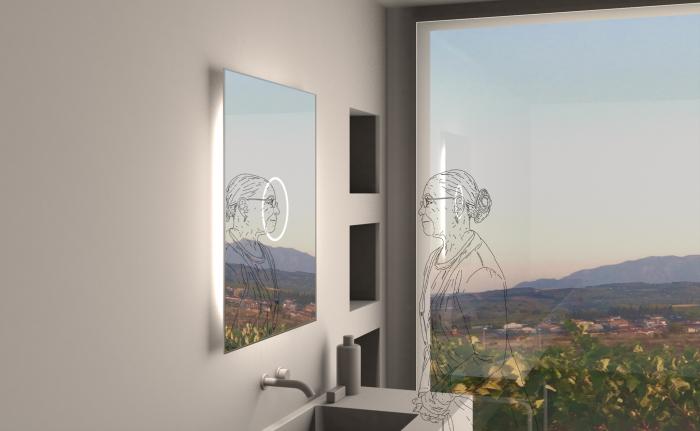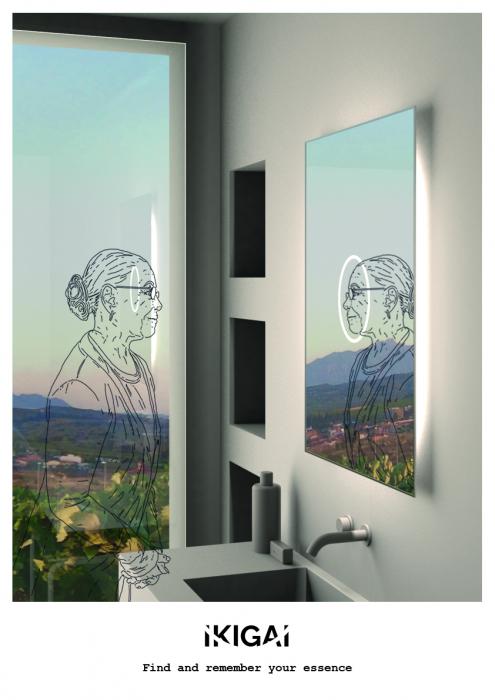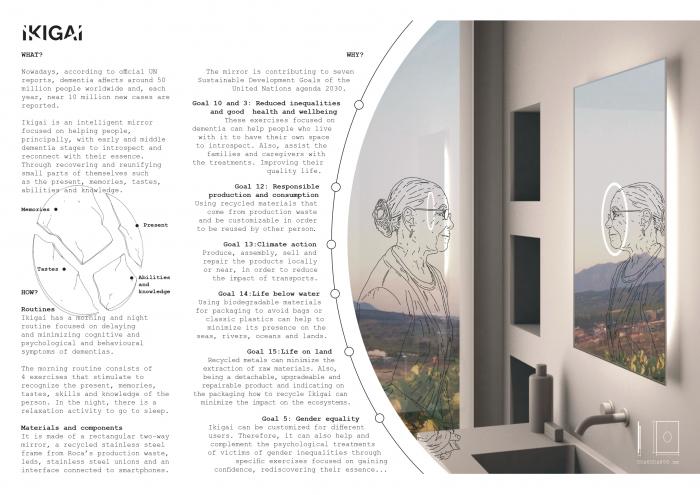Nowadays, according to official UN reports, dementia affects around 50 million people worldwide and, each year, near 10 million new cases are reported. Ikigai is an intelligent mirror focused on delaying and minimizing cognitive, psychological and behavioural symptoms of users with dementias through realizing a daily customized routines. It wants to help people, principally, with early and middle dementia stages to introspect and reconnect with their essence: present, memories, tastes,abilities.
Ikigai is an intelligent mirror focused on helping people, principally, with early and middle dementia stages to introspect and reconnect with their essence. Through recovering and reunifying small parts of themselves such as the present, memories, tastes, abilities and knowledge.
HOW?
Routines
Ikigai has a morning and night routine focused on delaying and minimizing cognitive and psychological and behavioural symptoms of dementias.
The morning routine consists of 4 exercises that stimulate to recognize the present, memories, tastes, skills and knowledge of the person. In the night, there is a relaxation activity to go to sleep.
Exercices
The exercises start in the morning and night only when the user comes closer to Ikigai and is distinguished by the facial recognition system. The rest of the day, it becomes a traditional mirror.
During the assistance, Ikigai helps users to concentrate on themselves surrounding their faces with an oval shape light.
The activities can be monitored and configured through a smartphone, always with the consent and customized for the person who has dementia. Also, the exercises can be changed throughout time according to the new preferences, necessities or symptoms of the user.
The mirror works on two of the three symptoms’ groups of dementias:
- Cognitive:alteration of memory, executive functions, learning, concentration and attention, aphasia, auditory and visual agnosia.
- Psychological and behavioural:depression, apathy, anxiety and sleep disturbance.
SUSTAINABLE DEVELOPMENT GOALS
The design is aligned to seven SDG of the United Nations agenda 2030. On one hand, it wants to empower, treat and foment personal autonomy and well-being of people who live with dementias. On the other hand, it wants to be sustainable through eco-strategies.
Goal3: Good health and wellbeing
Goal5: Gender equality
Goal10: Reduced inequalities
Goal12: Responsible production and consume
Goal13:Climate action
Goal14:Life below water
Goal15:Life on land
Please highlight how the concept/idea can be exemplary in this context
Ikigai wants to be environmentally sustainable through the adoption of green, blue and circular economy models. It can be exemplary in this context because this proposal is aligned with 7 of the 17 sustainable development goals of the 2030 Agenda of the United Nations and applies several sustainable strategies at all stages of the life cycle.
Materials (goal 12 and 15)In this stage, these goals are achieved through using recycled stainless steel for the mirror's frame that come from production waste. Recycled metals can minimize the extraction of raw materials, require less energy to obtain it and provide several lives to the used material. In addition, stainless steel can avoid paint finishes because it is corrosion resistant. Therefore, it is less harmful for the biodiversity and it contributes to a more responsible production and consumption.
Manufacturing and distribution (goal 13)These phases are addressed through the production, assembly, sale and repair of products locally and the design of a flat packaging, in order to reduce the transport used and its impact. Nowadays, according to UNECE reports, CO2 emissions of transportation supposes a 23% of the worldwide total.
Use (Goal 10,3 and 5)
In terms of affordability, Ikigai can be bought or hired in order to be reasonable for different budgets.
In terms of inclusion and accessibility, on one hand, these customized exercises focused on dementia can help people who live with it to have their own space to introspect. Also, assist the families and caregivers with the treatments. Improving their quality life and well-being of all the users.
On the other hand, Ikigai can be customized for other profiles. For example, it can also complement the psychological treatments of victims of gender inequalities through specific exercises focused on gaining confidence...
End of life (goal 14 and 15)
The product can be reusable, repairable, up-gradable, recyclable and detachable. Also, the packaging is biodegradable.
Please highlight how the concept/idea can be exemplary in this context
The key objectives of the physical aesthetics of design and the digital experience are, on the one hand, to focus all the user’s attention on themselves, on their reflection, and on remembering their interior or essence. On the other hand, implement eco-design strategies throughout the life cycle to maximize the sustainability of the product.
Physical Aesthetics
The physical aesthetics of the mirror are minimalist to cover the two main objectives: the attention and sustainability.
First, in order to minimize user distractions, in relation to colors, textures and shapes. Ikigai has a subtle stainless steel perimetral structure. It is smooth and preserves the natural color of this metal.
Also, inside the mirror, there are some LEDs that form an oval around the face of the user in order to help user to focus their attention on themselves and indicate the progress of activities.
Secondly, it is completely detachable and easy to recycle and repair its components thanks to the use of a single material for the structure and bracket unions. In addition, these strategies lengthens the life of Ikigai and/or of some of its parts.
Digital experience
The experience is designed to be adapted to three different users. It is developed through the mirror and through an application.
The mirror
The mirror experience is fully personalized for the primary user, the person living with dementia. The activities developed are chosen taking into account their preferences, tastes, situation, symptoms and the advice of the professionals who are treating them.
The application
The app is designed for professionals and the inner circle of the person suffering from dementia. This application can be used mainly to configure activities. In addition, it can monitor the results and evolution of the main user to provide information about each activity. This assessment can always be made with the consent of the person suffering from dementia.
Please highlight how the concept/idea can be exemplary in this context
Ikigai’s key goals in terms of inclusion are equal opportunities, accessibility, affordability, co-designed treatments, the well-being of people living with dementias and creating a community.
Equal opportunities
Ikigai wants to promote equal opportunities by providing daily routines to address the different symbiosis of dementias and improve the daily lives of its users.
Well-being
It also wants to reach well-being through working on personal autonomy and training users to do the exercises alone.
Accessibility
The virtual mirror experience is designed to be very easy to use through facial and voice recognition. The user just needs to be in front of the mirror and talk to him.
The application interface experience is adapted to a non-specialist audience in order to be easy to use for the patient’s inner circle.
Affordability
The mirror wants to be affordable for a wide range of budgets. For this reason, there are different ways to get this product: a purchase, a rental and a second-hand model.
Co-designed treatments
The mirror can facilitate the establishment of treatments by providing different results of exercises and taking into account user preferences, professional advice and family observations.
Community
In the future, the application can have a blog or an area to create a community to share experiences, knowledge and receive support from different families or professionals.
This concept can be exemplary because it has different plans for many budgets, provide an intimate experience for the main user to do introspection and perform autonomously different exercises, give the opportunity to co-design each exercise, help family and professionals with patient assessment and treatment and create a community.
Please highlight how this approach can be exemplary
Ikigai’s design and ideation was made by combining and taking into account inclusion, sustainability and aesthetics. The main reasons are the general objectives of this project: to help the community of people living with dementias and generate the minimum negative impact on the planet.
These three dimensions would be combined as follows in these two main parts of the project.
Application
The treatment will be co-designed and customized for each patient through an application compatible with all smartphones. Always, taking into account the preferences, background and symbology of each patient, the professional advice and the observations of the inner circle.
The results will be accessible and adapted to a non-professional audience in order to be easy to understand for the family and friends of the person living with dementia.
Mirror
Through having a minimal design, on the one hand, the mirror will provide an empowering experience, promote personal autonomy, help focus user attention and perform a treatment for dementias. On the other hand, this minimalist design will help align Ikigai with the different SDG and minimize its impact at every stage of its life cycle: using recycled materials, being detachable, upgradeable, recyclable, reusable...
There are many innovative characters of Ikigai compared to mainstream practices. These are the following ones:
Technological advancement
The facial and voice recognition system and artificial intelligence will be the first ones implemented in a mirror for medical purposes.
Digitize and customize a cognitive, psychological and behavioral treatment
The current cognitive, psychological and behavioral treatments led by professionals are physical: games, therapy... This can be a first step to introduce digitization in this medial field.
This can also provide to the patients a fully costumized experience adapted to their tastes, necessities, symptoms and the professional advices. Moreover, they can access easily to different kinds of exercises through the application without having to invest a lot of money in buying a lot of similar physical games.
Empower and foment personal-autonomy
Dementias are characterized for a gradual loss of personal-autonomy. Ikigai wants to provide them an intimate space to empower themselves and gain autonomy by doing the exercises alone.
Help the professionals and the inner circle with an immediate assessment
The app can generate immediate graphical results of the activities. This data can help the professionals and the family to understand how is evolving the person who is living with dementia. Therefore, this insights can help them to know better their situation and decide how to focus the next following treatment or activities.
ODS alignment
The mirror is designed taking into account eco-design strategies in all the life-cycle and 7 of 17 SDG. The product has the possibility to be accessible to different budgets and treat people with dementias while is minimizing its environmental and social impact in different areas.
The general plans I have to continue developing this project are five: research and co-design, recruitment, community, presentation or incubation and promotion.
Investigation and co-design
Firstly, I will continue to research dementias, their context, the sustainability and the technology needed for Ikigai. Secondly, in order to develop more accurately the activities and the experience, I will try to collaborate and co-design with TIAM1, an NGO in my city that helps people with dementias and where I volunteer. In addition, I will try to collaborate with other organizations, communities and volunteers who have dementias.
Recuirtment_
I would like to build a multidisciplinary team to develop more precisely each part of the project: software, electronics, interactive experience...
Community
I would like to generate a community trough the Ikigai's app and social media in order to connect different professionals (psychologists, caregivers...), families and people who lives with dementias. Therefore, this community can provide them an space to talk about many topics and recieve support.
Presentation or incubation
On one hand, I would like to talk with different bussiness in the health or furniture sector. The main objective is to know if they want to collaborate or buy the more developed project. On the other hand, I would like to find some professional incubator or accelerator to evolve the project.
Promotion
Try to present this idea to different competitions in order to make it visible, promote it and if I make money, invest it in the project, my education and maybe, if I have a lot of money, donate a part to dementia's research.
1. Website of TIAM: https://tiam.cat/qui-som/
Nowadays, the project is a concept that has recieved advices from TIAM, a dementia's NGO, to validate the current routines and has virtual prototypes. The initiatives that I would take if my project is awarded in the New European Bauhaus Prizes 2022 will be the following ones:
Investigation and co-design
I will continue to investigate dementias, technology and product sustainability. In parallel, I will try to collaborate with different associations related to dementias and design and try the exercises that are specified in the images. The main objective is to know if the exercises are well considered or need to evolve.
First prototype
First of all, I would like to make a team or hire the services of someone expert in electronics or software development. Secondly, I will try to make the first low-cost physical prototype of Ikigai to test the user experience and introduce virtual images during the activities.
Education
I would like to invest this money also on my education to improve as a professional for this and future projects.
Donation
If there’s any money left or the project for some feasible reason cannot be done, I would like to invest a substantial portion of the money in some dementia research organization or in TIAM.
@Millan Catala, 2022
Content licensed to the European Union.



